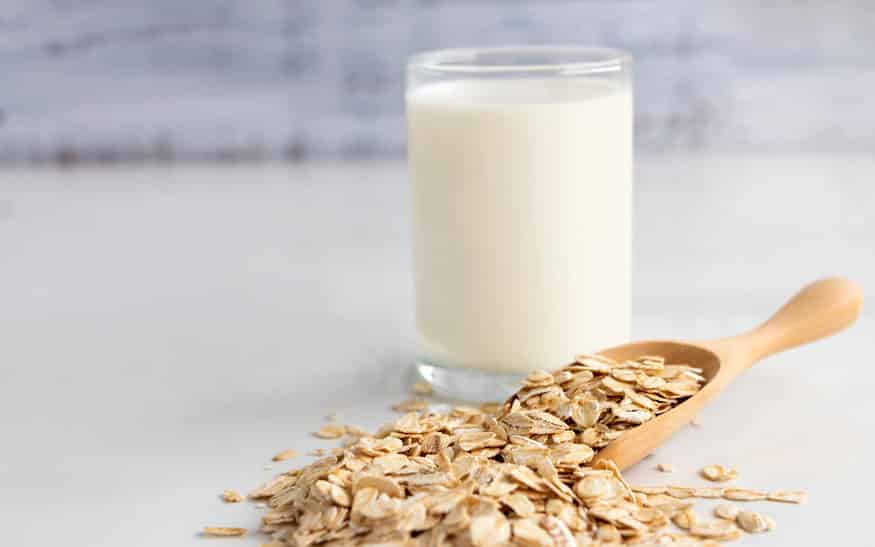By Jessica Scarpati –
The panic that fueled the 2020 toilet paper shortage may seem like a once-in-a-lifetime event. But a mere two years prior, America was in the throes of another moment of consumer scarcity: the great oat milk shortage of 2018. At its peak — or, perhaps, its nadir — a 12-carton case of Oatly’s oat milk products sold for about $200 on Amazon, amounting to about $17 per half-gallon.
Much to the relief of vegans, baristas, the lactose intolerant and other oat milk enthusiasts, supplies of this plant-based beverage have since bounced back. Meanwhile, Americans’ thirst for oat milk has only grown — by about 1,200 percent over the past two years, according to CNN.
So while oatmeal may be the old maid of grains, there’s no denying that consumers see oat milk as its more stylish, alluring cousin. That allegiance is due to oat milk’s nutty-like flavor and creamy texture — endearing it especially to coffee drinkers. But how does it measure up nutritionally? And is it any more, or less, eco-friendly than other plant-based milks?
Milking the benefits
One of oat milk’s most standout nutritional benefits — above cow’s milk and other plant-based milks — is its fiber content, which it owes to its high-fiber source material. That’s a good thing not only for a person’s gut but also their heart. The fiber found in oats is a soluble fiber known as beta glucan, which numerous studies have shown can lower blood cholesterol levels.
Although the process of turning oats into “milk” causes some of the fiber to be lost, oat milk typically retains about 2 to 3 grams of fiber per serving.
“While the leftover oat pulp has the bulk of the fiber and most of the protein in the oats, the liquid or ‘milk’ that results does have some of the nutrients in oats,” registered dietitian Kelly R. Jones told Shape magazine. “Because oats absorb water more easily than nuts, when blended well enough, more of the food itself winds up passing through the cheesecloth, giving a creamier texture than nut milk without added ingredients.”
In terms of protein, oat milk is inferior to dairy and soy, but it outperforms other plant-based milks, including nut-based ones like almond and cashew milk.
“If you’re replacing cow’s milk, which provides about 8 grams of protein per cup, with oat milk, which provides about 3 grams protein per cup, you may want to make up that protein from another food, such as a quarter cup of nuts or pumpkin seeds or a hard-boiled egg,” registered dietitian Cynthia Sass advised BuzzFeed News.
For those with allergies or sensitivities to dairy, soy or nuts, oat milk also provides a safe vessel for submerging Cheerios.
But beyond all that, oat milk’s benefits get a little, well, watered down. It tends to be higher in calories than other plant-based milks, and flavored varieties often contain added sugar. It also doesn’t have the nutrients found naturally in cow’s milk — including calcium, vitamin D and vitamin B12 — so experts recommend choosing a fortified product.
And like any processed food, oat milk loses many of the nutritional benefits found in its source material.
“If you are looking for health benefits from oat milk, you’re better off eating oatmeal,” Dr. Edwin McDonald IV, associate director of adult clinical nutrition at the University of Chicago Medicine, told The New York Times.
Additionally, if you’re not buying organic, consuming oat milk might actually be harmful to your health. Laboratory testing commissioned by the Environmental Working Group in 2018 found residues of glyphosate — a toxic chemical used in Roundup weed killer that has been tied to numerous health risks — in all 28 samples of products made with conventionally grown oats. In fairness, however, oats are far from the only crop at risk. Glyphosate is used heavily in genetically modified soybeans, and testing commissioned by the group Moms Across America in 2018 found traces of the chemical in almond milk.
Seeking Sustainability
Before oat milk splashed onto the scene, almond milk was the darling of plant-based milks — that is, until consumers realized just how environmentally unfriendly almond production can be. Almonds have an especially high water footprint, which is particularly concerning in drought-prone California, where most of the world’s almonds are grown.
Every liter of almond milk takes 371 liters of water to produce, compared to 48 liters of water for oat milk, Curtin University researchers Dora Marinova and Diana Bogueva explain on The Conversation.
Still, that’s nothing compared to cow’s milk. It takes 628 liters of water to produce a liter of dairy milk, they note.
Oats also have the benefit of already being part of the agricultural landscape, meaning that oat milk production doesn’t necessarily require a lot of additional land use.
“Right now, 50 to 90 percent of global oat production goes into animal feed, so there’s a huge existing acreage that we can safely steal share from without moving the needle at all on total production,” Liz Specht, associate director of science and technology for the Good Food Institute, told The Guardian.
Though when it comes to choosing between almond, oat, soy, rice or other plant-based milk, experts say any choice is better for the planet than conventional dairy.
“Drink what you want,” food sustainability consultant Isaac Emery said in an interview with The Guardian. “If you’re going with plant milk instead of animal milk, you’ve already addressed most of the environmental problems that your animal milk habit was causing.”











